Symmetry: In Geometry, when two parts of an image or an object become identical after a flip, slide, or turn then it known as symmetry....

Symmetry: Know What is Symmetry in Geometry
December 2, 2024
Respiratory Organs in Animals: What is respiration? Respiration is one of the life processes, which involves the oxidation of food in the cells. Respiration involves the exchange of gases. But how does this process occur in different animals? It occurs through respiratory organs. What are the respiratory organs in aquatic animals? Respiratory organs in different animals are different and it is a very interesting topic for the students to learn.
What should be the criteria that a respiratory organ should have? How do simple and complex organisms carry out this process? Read through the article to find out more about common features of respiratory organs in aquatic and terrestrial animals, the evolution of respiratory organs in different animals and much more!
Respiration generally involves the oxidation of food in the cells by using oxygen taken from the environment with the production of energy, carbon dioxide and water. Energy is stored in the bonds of ATP for use in biological activities. Organs that are involved in gaseous exchange during respiration are called respiratory organs. Like in humans, a pair of lungs are present, and in fish, gills are present, which are involved in the gaseous exchange.
Check out common features of respiratory organs in aquatic and terrestrial animals below.
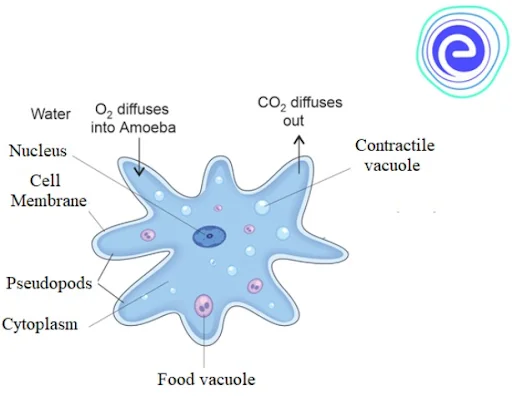
Fig: Cell membrane in Amoeba
Oxygen is present in the water. By the process of simple diffusion, oxygen enters the cell membrane of the Amoeba, and after the process of respiration, \({\rm{C}}{{\rm{O}}_{\rm{2}}}\) is evolved, which is given out through the cell membrane by the process of simple diffusion. Through this process of respiration, energy is released.
Oxygen from the atmosphere is absorbed through the skin, and then it is diffused to the blood, and through blood, it is transported to all parts of the body. When oxygen reaches each cell, respiration takes place, during which carbon dioxide is evolved, which is expelled out of the body through the skin by the diffusion process.
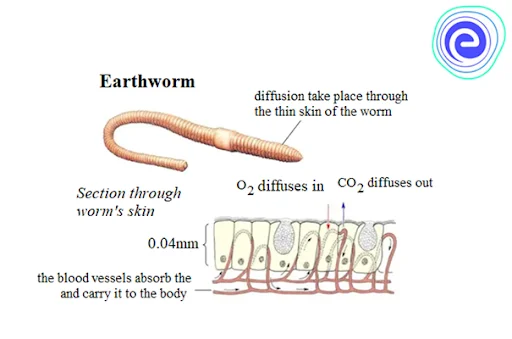
Fig: Respiration in Earthworm
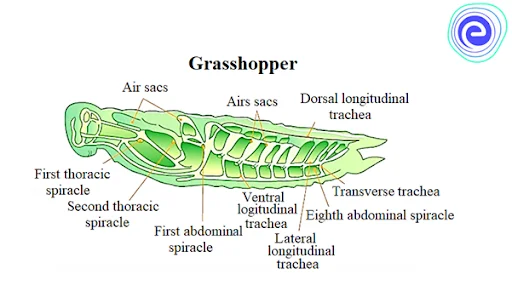
Fig: Tracheal system in grasshopper
Alternate contraction and expansion of the abdomen expel and take air in the tracheal system. When the abdomen expands, inspiration takes place. And when the abdomen contracts, the air is expelled through the spiracles.
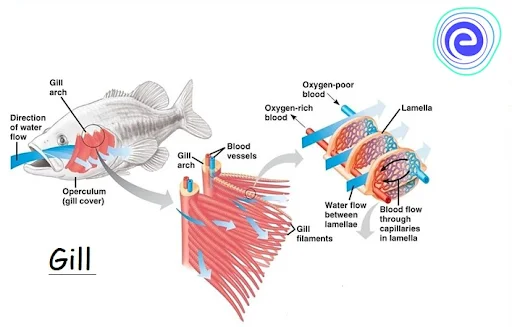
Fig: Gills in fishes
Fish use dissolved oxygen from water. Water enters the mouth of fish, which is then passed through the gills where the dissolved oxygen is extracted by gills, and the water goes out through gill slits. Blood absorbs oxygen from the gills, which is carried to all parts of the body of the fish. Then after respiration, carbon dioxide is produced, which is brought to the gills through the blood and is expelled out of the body into the water.
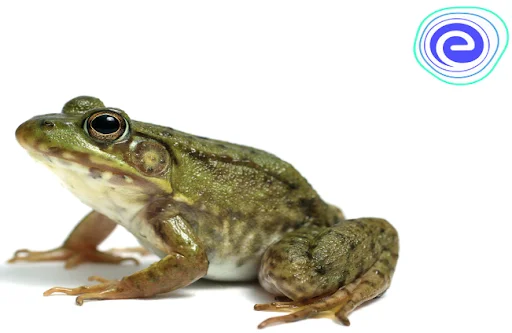
Fig: Frogs
Frogs can respire through:
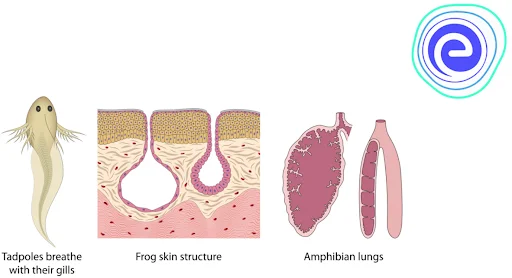
Fig: Different Respiratory Organs in Frogs
During respiration, there occurs an exchange of gases, i.e. oxygen is taken in, and carbon dioxide is thrown out of the body. This process gives energy to the frog and tadpole for different biological activities.
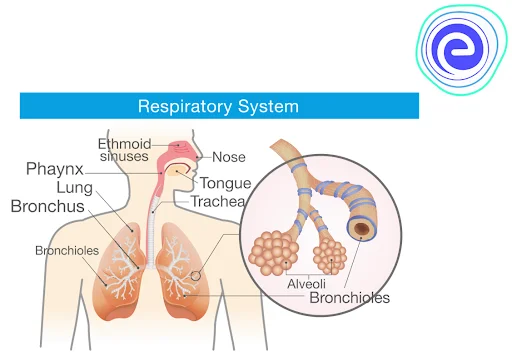
Fig: Respiratory System in Humans
We breathe in air through our nostrils, and that air enters our respiratory tract. The respiratory tract serves as a passageway for the fresh air to flow from outside to the lungs. Air containing oxygen enters through the nose to the trachea, which leads to the lungs. Inside lungs, air containing oxygen enters bronchi, bronchioles and finally the alveolar sac. In this sac, gaseous exchange occurs. Alveolar sacs increase the surface area of the lung. Oxygen is taken up by blood and is transported to all cells of the body where oxidation of food occurs, and then carbon dioxide is released, which is transported to the lungs back by blood and is then expelled out through exhalation.
Students are also interested in the evolution of respiratory organs in different animals. Check out the respiratory structure for the exchange of gases in different groups of animals below.
| Animal group | Respiratory Structure |
| Protozoan | Plasma membrane |
| Cnidarians | Body surface |
| Platyhelminthes | Body surface |
| Nemathelminthes | Body surface |
| Annelids | Skin |
| Arthropods | Gills, trachea, book lungs, book gills |
| Molluscs | Gills, pulmonary sac |
| Echinodermata | Dermal branchiae, tube feet |
| Chordata | Gills, Lungs |
In this article, we learnt about different respiratory organs in different animals including respiratory organs in aquatic animals. Respiratory organs should be moist, thin, highly vascularised and should have a large surface area for the exchange of gases. Respiratory organs in simple organisms like Amoeba is the cell membrane through which gaseous exchange occurs. In earthworms, the exchange of gases occurs through the skin, while in fish, the respiratory organ is the gill. In frogs, respiration can take place through either skin or lungs, depending on which medium it is present. If a frog is inside the water, then an exchange of gases occurs through the skin, and when it is on land, it occurs through the lungs. Tadpoles of frogs respire through gills. In insects like grasshoppers, tracheal respiration takes place. In humans, respiration occurs through the lungs. Respiration is an essential life process as the required energy is released through respiration and stored as ATP.
Q.1. Which animal has a skin respiratory organ?
Ans: Earthworms have skin as their respiratory organ.
Q.2. What is the main function of the lungs in a human body?
Ans: Lungs are involved in gaseous exchange during the respiration process.
Q.3. What are the respiratory organs of amphibians?
Ans: Respiratory organs of amphibians like frogs can be either skin, lungs or gills.
Q.4. What are the respiratory organs of mammals?
Ans: Respiratory organs of mammals are the lungs.
Q.5. What are the respiratory organs in fishes?
Ans: Respiratory organs in fishes are gills.